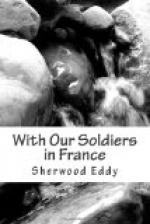On another occasion we were with the army of Australian and New Zealand troops, as they were marching by the King at their last review before going to the front. Fortunately, we had secured standing room near the King’s side, where we could watch every smile and action as he saluted each passing battalion, and we could even hear him speak a kind word now and then to some officer. There were generals to the right of us and to the left of us, colonels, majors, captains, officers of every rank, and prominent civilians; but the greatest man on that field was the soldier himself. With what a swing those clean-cut young Australian boys marched past; every man was a volunteer and part of that great first army of over four millions of men who came forward for the defense of the Empire without conscription.
Hundreds were playing in the massed bands, as the long file of men marched by. But time and again the firm columns seemed to fade before us, and we could not see them for tears, as we realized that many of these brave boys were going forward to die for us. Above, a great aeroplane was looping the loop and warplanes were darting to and fro.
Away on the horizon stood the great boulders of Stonehenge, erected long before the time of the Saxons, the Britons, or even the ancient Druids, by the sun-worshippers, who offered their human sacrifices on the ancient altar there nearly forty centuries before. We looked at those stones, where through a mistaken conception of God and an inadequate conception of man, human sacrifices were offered long ago. Suddenly we heard the crack of the rifles of a body of troops at practice, moving forward in open line of battle. Today, through a mistaken conception of God and a low conception of man, over 5,000,000 of men have already been killed, offered in human sacrifice; while many millions in lands devastated are homeless, starving, or ruined in body or soul—these are part of the offering, forced upon humanity by a godless materialism, while a divided Christian Church stands by impotent.
II
Let us now visit Egypt where we shall witness very different scenes. Away on the distant horizon are the two triangular points, which grow as we approach into the outlines of the great pyramids. Beyond are the fifty-eight centers which have risen along the banks of the Nile, in the metropolis of Cairo, and in the harbors of Port Said and Alexandria, and which line the Suez Canal and dot the desert even out into the peninsula of Mt. Sinai. The sun is setting as we climb the great pyramid, which stands a silent witness to forty centuries of history which have ebbed and flowed at its base, but surely no stranger sight has it ever seen than these armed camps about it, engaged in this titanic struggle of the world. Away to the south towards far Khartoum, like a green ribbon in the yellow desert, stretches the irrigated basin of the Nile. Beyond it is the bottomless burning sand of the Sahara.




